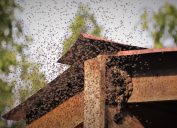"Vicious and Relentless" Otter Attacks Are on the Rise—How to Protect Yourself
They may be cute, but the aquatic mammals have left some people with gruesome injuries.

When people think of potentially dangerous animals awaiting them in the water, it's safe to say that fear of an otter attack is not usually high on the list. If anything, you're likely picturing an adorable, furry, aquatic mammal that spends its time breaking open shellfish on its belly or floating on its back while holding hands with one of its friends. But now, a bizarre string of "vicious and relentless" otter attacks is turning otters' cuddly reputation on its head. Read on to see why these encounters are on the rise and how you can protect yourself.
RELATED: "Very Large" New Spider Species Discovered—Here's Where There May Be Hiding.
One otter in California has been aggressive towards surfers—and even stealing their boards.

Most surfers tend to worry about getting cut off during a ride or even the occasional shark while catching waves. But in Santa Cruz, California, a peculiar string of incidents with a local otter has some authorities concerned for public safety.
Multiple surfers have reported run-ins with Otter 841, a five-year-old female who has broken natural norms by approaching people in the water and biting their surfboards, The New York Times reports. Authorities say she was born and raised at the Monterey Bay Aquarium, where her caretakers tried to avoid affecting her healthy natural fear of humans before she was released into the wild. But unfortunately, several reports have made it clear she's anything but timid.
In one incident this summer, a surfer said she approached him and bit off his ankle leash before she got on his board and began biting out large chunks out of it while he watched from afar, per The Times. The previous month, another surfer reported that Otter 841 jumped onto his board and rode a wave after he abandoned it.
While no one has been injured so far, there is still plenty of reason for concern. The seemingly adorable mammals "have sharp teeth and jaws strong enough to crush clams," Gena Bentall, director and senior scientist with the preservation organization Sea Otter Savvy, told The Times.
Officials have also become especially cautious since Otter 841 has become something of a social media sensation. "Due to the increasing public safety risk, a team from CDFW [California Department of Fish and Wildlife] and the Monterey Bay Aquarium trained in the capture and handling of sea otters has been deployed to attempt to capture and rehome her," a spokesperson for the CDFW said in a statement, per The Times.
RELATED: 20 Rattlesnakes Found in Man's Garage—Here's Where They Were Hiding.
A Montana woman was also gravely injured by a river otter in August.

It's not just the ocean where frightening incidents have occurred. On Aug. 3, Jen Royce was floating down the Jefferson River near Bozeman, Montana in an inner tube when an otter approached and attacked her and her two friends.
"I saw one otter right behind my friend before it attacked," Royce wrote in a Facebook post about the incident, per The New York Post. "I didn't even have a chance to get the words 'there is an otter behind you' out of me before it attacked her."
She said the animal was "vicious and relentless" during the terrifying ordeal, which left all three women injured. "It bit my face in several places, both of my ears, my arms, my hands, my legs, my thighs, and my ankle," she wrote in the post. "My friends were bit on the hands and on their bottoms. One friend's thumb was shredded and she has bite marks all over her body as well."
Joyce recounted that the extent of her injuries included "puncture wounds to my left ankle, both legs, back of my right thigh, both arms, both hands, and all fingers," adding that she had "lost almost half of my right ear." Eventually, the group found help and was airlifted via helicopter to a nearby hospital for emergency treatment, ABC News reports.
RELATED: Residential Bear Attacks Are on the Rise: What You Need to Know.
A rabid otter seriously injured a Florida man and a dog recently.

On Sept. 20, a Florida resident Joseph Scaglione also had a harrowing experience while feeding ducks and geese behind his home in Palm Beach County. After realizing the birds had suddenly scattered, he noticed a "brown head sticking up over the bank of the pond" behind his property, local Fox affiliate WSVN reports.
Scaglione says he then began slowly backing toward his gate but was attacked by the animal just as he was going to close it. The surprise caused him to fall to the ground, where the otter bit him 41 times on his hands, legs, and arms before he could toss the aggressor away and make it to safety.
Not long after, a couple walking with their baby and pet dog were confronted by the animal nearby. The otter began to attack the canine before nearby residents captured the animal by placing a plastic recycling bin over it, WSVN reports.
Local animal control officials later tested the otter and confirmed it was rabid. Fortunately, Scaglione has since undergone treatment for rabies and is recovering from his wounds, telling the news outlet he's already gone back to feeding the geese and ducks.
RELATED: Multiple People Attacked by "Cloud of Hundreds of Bees"—How to Protect Yourself.
Officials warn that otter attacks are "rare" but still possible, especially when they're stressed.

The recent string of incidents goes against the normally cuddly and friendly reputation that otters tend to enjoy with the public. But officials caution that the animals can pose a serious risk in some cases.
"While attacks from otters are rare, otters can be protective of themselves and their young, especially at close distances," authorities from Montana Fish, Wildlife & Parks (FWP) said in a statement following the August attack. "They give birth to their young in April and can later be seen with their young in the water during the summer. They may also be protective of food resources, especially when those resources are scarce."
The agency advises anyone enjoying nature to "keep a wide distance, giving all wildlife plenty of space," especially during drought conditions that can lower water levels and bring people closer to water-dwelling wildlife. "Being aware and keeping your distance can help avoid dangerous encounters, reduce stress for wildlife, and promote healthy animal behavior," the Montana FWP said in its statement.
And those who find themselves in danger should never forget one thing: "If you are attacked by an otter, fight back, get away and out of the water, and seek medical attention," the agency advised.
For more news sent right to your inbox, sign up for our daily newsletter.





















